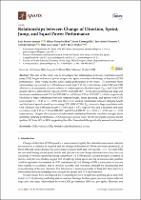Please use this identifier to cite or link to this item:
https://repositorio.usj.es/handle/123456789/520
| Title: | Relationships between Change of Direction, Sprint, Jump, and Squat Power Performance |
| Authors: | Suarez-Arrones, Luis


Gonzalo-Skok, Óliver 

Carrasquilla, Irene 

Asian-Clemente, Jose 

Santalla, Alfredo 

Lara-Lopez, Pilar 
Núñez-Sánchez, Francisco Javier 


|
| Keywords: | COD; Velocity; CMJ; Abalakov; Flywheel inertial device |
| Issue Date: | 19-Mar-2020 |
| Publisher: | MDPI |
| Citation: | Suarez-Arrones, L., Gonzalo-Skok, O., Carrasquilla, I., Asián-Clemente, J., Santalla, A., Lara-Lopez, P., Núñez, F.J., 2020. Relationships between Change of Direction, Sprint, Jump, and Squat Power Performance. Sports 8, 38.. doi:10.3390/sports8030038 |
| Abstract: | The aim of the study was to investigate the relationships between countermovement jump (CMJ) height and inertial power in squat and sprint variables with change of direction (COD) performance. Fifty young healthy active males participated in the study. To determine these relationships, we carried out a 10-m linear sprint test (T 10 m), vertical jump tests (CMJ and CMJ Abalakov), an assessment of power relative to bodyweight in a flywheel squat (Pbw), and 10-m COD sprints with two different turn types (COD-90◦ and COD-180◦ ). T10 m showed statistically large and moderate correlations with T10 m COD-180◦ (r = 0.55) and T10-m COD-90◦ (r = 0.41), respectively. Moderate to large correlations between jumping height, linear sprinting, and sprints with COD were found (r = −0.43 to r = −0.59), and there were unclear correlations between jumping height and the loss of speed caused by executing COD (DEC-COD). Pbw showed a large correlation with CMJ Abalakov and CMJ jump height (r = 0.65 and r = 0.57, respectively), and a moderate and large correlation with T 10 m, T 10 m COD-180◦ , and T10 m COD-90◦ (r = −0.33, r = −0.38, and r = −0.54, respectively). Despite the existence of substantial correlations between variables, straight linear sprinting, jumping performance, CODs and squat power were, for the most part, separate motor qualities (R2 from 14% to 34%), suggesting that all of them should be specifically assessed and trained. |
| URI: | https://repositorio.usj.es/handle/123456789/520 |
| ISSN: | 2075-4663 |
| Appears in Collections: | Artículos de revistas |
Files in This Item:
| File | Description | Size | Format | |
|---|---|---|---|---|
| Relationships between Change of Direction, Sprint, Jump, and Squat Power Performance.pdf | 869,17 kB | Adobe PDF |  View/Open |
This item is licensed under a Creative Commons License

